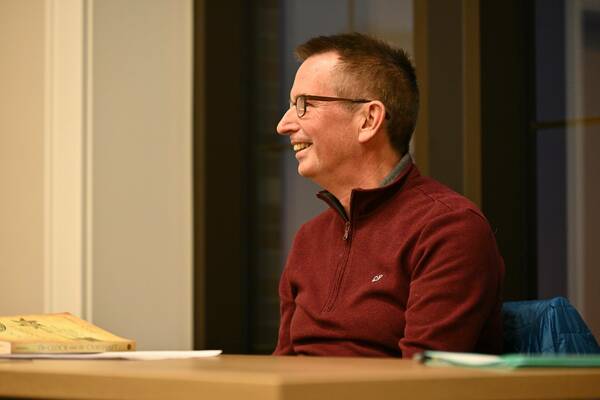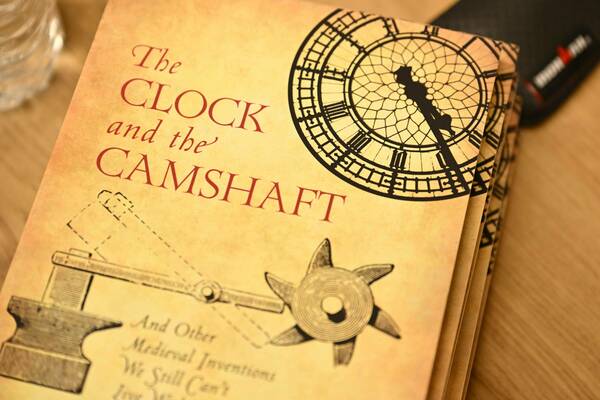Technology in the Middle Ages? You bet! Popular author John Farrell visits ND and South Bend to discuss

If you are wearing eyeglasses to read this page, you are benefiting from a medieval invention. Spectacles, wind mills, mechanical clocks—all these technologies and more come to us from the Middle Ages. Audiences around South Bend had the opportunity to learn about this history from visiting author John Farrell, whose second book, The Clock and the Camshaft: And Other Medieval Inventions We Still Can’t Live Without, is just out from Prometheus Books.
Farrell gave a book talk on Wednesday, March 2, at the Main Library in downtown South Bend, to an audience of ten people from the local community. This event launched a new partnership between the University of Notre Dame’s Medieval Institute and the St. Joe County Public Library. Farrell shared his thesis that, whereas today we think technology drives cultural change, in the Middle Ages it was the other way around. Medieval societies developed technology to address changes that were already transforming their world. For example, increases in agricultural production impelled farmers to refine tools for grinding grain more efficiently. Improving upon the vertical and horizontal water mills they had inherited from Rome, they then deployed the same crank mechanism to crush ore, full linen and power forge bellows. These more efficient means of production, in turn, supported the growth of cities during a period of urban and commercial revolution.
On Thursday, March 3, Farrell came to the University of Notre Dame campus to talk with ten students and faculty in the Scholar’s Lounge of Hesburgh Library about science writing for public audiences. Facilitating the conversation, Robert J. Goulding, Associate Professor in the Program of Liberal Studies and Director of the John J. Reilly Center for Science, Technology and Values, asked Farrell how he came to write a book about medieval technology. Farrell explained that his long-term interest in the intersection of science and faith led him to wonder, What role had the church played in the rise of science? He began thinking about the reception of Aristotle in medieval universities and then became fascinated by the efforts of ordinary medieval people – millwrights and blacksmiths – to promote human flourishing. He wanted to celebrate these anonymous innovators who solved practical problems to improve the quality of life in their communities.

Additionally, Farrell made a guest appearance at John Adams High School in South Bend to speak to students enrolled in the new elective course offered there by the Medieval Institute. In line with the course’s emphasis on medieval cultural encounters, Farrell introduced the students to the transcontinental exchange of technology in the Middle Ages. Paper, for example, was first produced in China, then passed through the Islamic world to Spain and thence into Europe where it enabled the fifteenth-century print revolution. Farrell shared research tips with the students, most of whom will begin college next fall.
The Medieval Institute was delighted to strengthen its community partnerships through these events and introduce life-long learners beyond campus to the legacy of medieval science and engineering from which we still benefit today.